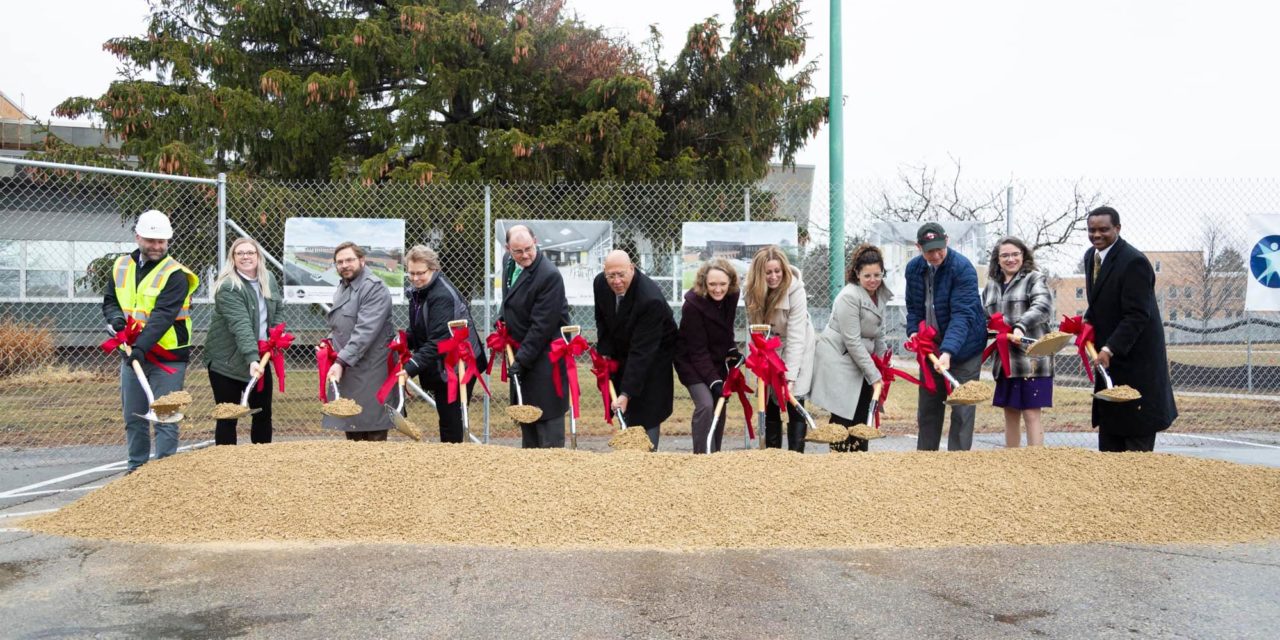
DHS’ Mendota Juvenile Treatment Center expansion part of broader overhaul

Photo credit: Department of Health Services
State officials recently broke ground on an expansion of the Mendota Juvenile Treatment Center in Madison, which provides mental health treatment to some of the most troubled people in Wisconsin’s youth justice system.
The expansion is part of an overhaul of the system that includes the closure of youth prisons in Irma once replacement facilities are built.
“A lot of people in a lot of places had to pull together to agree that this was a good direction,” said Dr. Gregory Van Rybroek, the director of Mendota Mental Health Institute. “And that is not an easy thing to do.”The three-year, $65.9 million project will allow the center to serve more patients, including girls for the first time.
Van Rybroek recently spoke to Wisconsin Health News.
Edited excerpts from the interview are below.
WHN: You’ve been involved with this program since its creation in 1995. How does its approach differ from what’s available to a lot of juvenile offenders? What makes it unique?
GVR: One of the unique parts of it is in where it is located, and I don’t mean like the geography directly. It is part of the Department of Health Services, which is a different model than models around the country for dealing with juveniles. Typically, juveniles are somewhere in the juvenile correctional system, in terms of agencies. So that’s a distinction with a difference because the health services or mental health services areas have just by history, philosophy and practice a much stronger mental health focus. So that is a piece that matters.
The other thing that is closer to today is this Act 185, which is several years old now. That essentially is about what usually is termed juvenile justice reform, and that really means looking at juvenile justice through the lens of rehabilitation than through a lens that is closer to corrections in the traditional sense. And what we have done here at Mendota over this period of time, because we’ve had a small juvenile program for about 25 years, is created what sometimes we call a clinical-correctional hybrid model, where we use the security and safety that is necessary at times concerning youth who have a history of challenging behavior and dangerous behavior. And the model is really all about trying to help people who are in a very, very bad spot.
So what I said at the groundbreaking … the role of the state is to help people who need this kind of help, and the construction is part of that. And then the role of Mendota here is to help the staff help the patients help themselves. That is a little easier to say than it is to do because we need each one of those help words to connect in sort of a linear way in order to set up the right conditions for helping. And helping is a soft word. Everybody in their heart wants to help, but to actually help in an active way, past being empathetic toward people who have been in very bad life situations at a young age, is actually difficult to do that because of the many conditions that have to be set in a direction toward that end. If help was easy, we would all get an injection of it, wouldn’t we? And everything would be good. But help isn’t easy. Help is actually a complicated, integrated approach that takes a lot of people aligned toward that end. But to get there is the difficult part. And that’s what this is about: setting the conditions to help kids who are in a bad spot.
WHN: This program has been around for more than two decades. What have been its results?
GVR: When it was started, we looked around the country for programs that had dealt with sort of the deep end of kids in the juvenile world. And the literature and the philosophy was that nothing works. And when you have that as sort of the ground that you stand on, that helps propel other ideas such as waiver of kids into adult court because really we have nothing in our world to offer. So that’s where we started, and we couldn’t learn that much frankly from other places because we had not developed programs.
So necessity becomes the mother of invention, I guess, and we created a model of care that we call decompression. A decompression model in a clinical way, meaning helping people who are troubled, means to take them where they are, which is in a bad circumstance, and they often are compressed down by the system, very restrictive conditions because they are so difficult and dangerous. And then to decompress them is to do a treatment approach. Very, very gradually, sort of slices of treatment where the young person who attributes malevolence to most people, because that’s lots of times where they came from, don’t have a lot of trust, where they get gradually more and more trust in a staff that are trying to be firm, fair and, perhaps most important, compassionate, about the young person’s circumstance, such that the young person doesn’t want to do well for intrinsic reasons, to gain rewards, which we certainly do here in what psychologists call contingency management, but that through time, they intrinsically take in that people are actually trying to help them. And they can actually get a slice of hope inside of them. You can imagine how hopeless and helpless a person might feel if they do not come from a structure that takes care of them regularly, that they can’t trust because they have no experience of what that is like. So to get that at a fairly old age when you think about a teenager – we all had that, I hope, every single day for most of our lives to age 16 there, and that is a more solid psychological foundation, and that is the difference between being who we were at age 15, 16 than who that person typically is at 15, 16. Of course, that’s all the difference in the world.
And then the research, we’ve studied it. It’s not just something that we sort of think of in theory as a good idea, because more people would say in theory rehabilitation is a good idea for youth. But we actually followed youth out and compared them to a group of youth that were similar but not in the intensive treatment environment. And the results show a reduction in recidivism, particularly for high crime, felony crime, in half after a four-and-half year period. That’s really mind bending. We should pay attention to that. And in our state, we did.
WHN: What are the expansion plans? What is it going to allow you to do that you haven’t been able to do before?
GVR: In the end, about three years or so, we’ll go up from about 29 beds to 93 beds. And a new part of it will be beds for females, so there will be 20 beds for females and 73 beds for males. Then we will also have … areas having to do with treatment, classrooms for school. We are actually building a house inside there. Don’t think of a house with a roof in a traditional sense, but the inside of a house like a kitchen area, a living space, a computer-library area, a music area, art studios. We’ll also have physical exercise space, inside and outside. And lots of therapy space. Therapy in this population will be individual, groups, family, medicine when that is needed.
And the idea is to have a connection with the youth’s county from the day of admission until discharge. Sometimes we say the first day of admission is where we begin the discharge plan. And the reason we say it that way is because we don’t want people to come to Mendota for a real long time. We want them actually to be where they need to be in a safe environment with the purpose of providing them treatment so that they can get into a better space to be returned to their county of residence and to continue on with whatever their needs are. So this way, it’s a shared partnership if you will and collaboration with the state agencies – so (The Department of Children and Families) and juvenile corrections in the Department of Corrections – and then all of the various county services. So DHS has sort of the central place for serious mental health assessment and treatment for juvenile boys and girls.
And everything that I said there is pretty much a sea-change. Because the original 25 years, all of the youth were coming in through juvenile corrections alone. And the future will be that everybody will have access to this kind of treatment here in Wisconsin.
WHN: How does this fit into the overall reform of the state’s juvenile justice system?
GVR: I think the department has made the proposition that we the department want to be available for the entire state, so that’s a big reform right by itself …
At the end of this construction, we want to be prepared to work with the most challenging and difficult youth, but with an understanding that it isn’t a one-way street. It actually is a two-way street because the continuum of care demands that the youth needs to be in the community as well. And why is that? Well, because if it were you or me, and we were in this troubled space, we would want to not be placed inside a treatment facility, even if it is effective. We’d only want to be there as long as it is needed for us.
And that’s our job is to sort that out. So it’s an agreement, a partnership statewide that there’s an understanding that we only want youth here for the length of time that it’s necessary to help them. And they then need to get a next step back out into the community. And that’s pretty easy, again, to say. But it requires developing systems that understand that and actually can live up to that ideal.
This article first appeared in the Wisconsin Health News daily email newsletter. Sign up for your free trial here.





